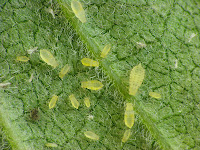 |
| Polished lady beetle (Cycloneda munda) on dying milkweed leaf |
The milkweed food chain would be incomplete without
predators and parasitoids. Most of them are out of sight in November; but a few
are around feeding on whatever is available, mostly aphids.
 |
| Multicolored Asian lady beetle (Harmonia axyridis) pupa |
 |
| Multicolored Asian lady beetle adult |
Another type of aphid eater is present in numbers and feeds on the two species of aphids mentioned in the previous post. The larvae of syrphid flies are blind and worm-like, lacking legs. Despite these disadvantages, they have no trouble finding aphids to feed upon, provided that the mother was careful enough to lay her eggs near a growing and prosperous colony of aphids.
 |
| Syrphid larva (Eupeodes americanus) |
 |
| Syrphid larva (Eupeodes americanus) |
It is impressive to see these maggots thrashing around until they find a plump juicy aphid. They hold it with their strong mouth parts and proceed to suck all the internal fluids until the prey is reduced to a deflated piece of skin. You can see the front end of the larva acting as a pump, expanding and contracting. Oddly, the other aphids in the colony have no fear, no premonition of what is in store for them. I have seen them approaching and then walking all over a syrphid maggot in total indifference.
 | ||
| Syrphid larva (Eupeodes americanus) |
In a couple of weeks this will be all over. No more active
life in the milkweed patch; just a few flying seeds carried by their fluff. The
monarchs are long gone. All others remain in the area in hidden places safe
from the weather and from the occasional winter predator. They will all return
to their usual activities next year, when the milkweeds start sprouting new
shoots and providing nourishment to them.
Milkweed's last hooray
List of articles
© Beatriz Moisset. 2012









